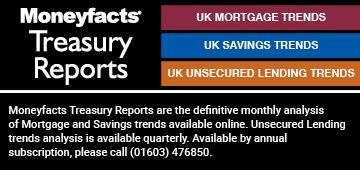Eleanor Williams, Finance Expert at Moneyfacts, said:
“Would-be mortgage borrowers will find that the level of product choice they are faced with has dropped again this month, now down to a level not seen in over a year (April 2021 – 3,842). This month began with 3,890 deals to choose from – a notable 1,425 fewer than the 5,315 products on offer in December 2021. The average product shelf life rose to 28 days in September, up from the record low of 17 days last month, but rather than this indicating a more stable mortgage market, when considered alongside the significant number of product withdrawals it may instead be a sign that lenders are tightening and condensing their ranges and focusing their product offerings.
“It’s unlikely to be a surprise that average rates have continued to march upwards, with both the average overall two- and five-year fixed rates rising for the 11th consecutive month. The average two-year fixed rate is 4.24%, the highest since January 2013 (4.24%), and 1.90% above where this sat in December 2021. The equivalent average five-year fixed rate of 4.33% is the highest since November 2012 (4.47%), an increase of 1.69% since December 2021.
“This may well be disappointing for many, particularly those with a now maturing two-year fixed rate deal who may be feeling rather concerned that at 4.24% the overall average rate is now 2.00% higher than when they secured their deal (September 2020 – 2.24%) – which may equate to payments on average of over £200 per month more than they have been used to paying*. However, it’s important these borrowers are not put off exploring their options, as the average SVR or revert to rate has also risen, currently sitting at a 5.40% - the highest we have recorded in over 13 years (Dec 2008 – 5.68%). Those who fall onto this could see their payments rise by an even more dramatic £344*, and of course would not be protected from any future rate rises.
“As may be expected, the average two-year tracker rate has also risen, shifting in line with the recent base rate increases. At 3.33%, this is 1.75% higher than the equivalent average rate in December 2021 (1.58%). While this is lower than the current average two- or five-year fixed rates, it’s important that those tempted by one of these products, especially if that preference is based on the lower initial rate, speak to a qualified adviser to consider the implications. With another base rate rise possible this month, and the chance of two further increases before year end, ensuring their mortgage remains affordable if rates continue to increase is vital.”
* Calculations based on a mortgage balance of £200,000 over a 25-year term, at rates of 2.24%, 4.24% and 5.40%.
Eleanor Williams, Finance Expert at Moneyfacts, said:
“Would-be mortgage borrowers will find that the level of product choice they are faced with has dropped again this month, now down to a level not seen in over a year (April 2021 – 3,842). This month began with 3,890 deals to choose from – a notable 1,425 fewer than the 5,315 products on offer in December 2021. The average product shelf life rose to 28 days in September, up from the record low of 17 days last month, but rather than this indicating a more stable mortgage market, when considered alongside the significant number of product withdrawals it may instead be a sign that lenders are tightening and condensing their ranges and focusing their product offerings.
“It’s unlikely to be a surprise that average rates have continued to march upwards, with both the average overall two- and five-year fixed rates rising for the 11th consecutive month. The average two-year fixed rate is 4.24%, the highest since January 2013 (4.24%), and 1.90% above where this sat in December 2021. The equivalent average five-year fixed rate of 4.33% is the highest since November 2012 (4.47%), an increase of 1.69% since December 2021.
“This may well be disappointing for many, particularly those with a now maturing two-year fixed rate deal who may be feeling rather concerned that at 4.24% the overall average rate is now 2.00% higher than when they secured their deal (September 2020 – 2.24%) – which may equate to payments on average of over £200 per month more than they have been used to paying*. However, it’s important these borrowers are not put off exploring their options, as the average SVR or revert to rate has also risen, currently sitting at a 5.40% - the highest we have recorded in over 13 years (Dec 2008 – 5.68%). Those who fall onto this could see their payments rise by an even more dramatic £344*, and of course would not be protected from any future rate rises.
“As may be expected, the average two-year tracker rate has also risen, shifting in line with the recent base rate increases. At 3.33%, this is 1.75% higher than the equivalent average rate in December 2021 (1.58%). While this is lower than the current average two- or five-year fixed rates, it’s important that those tempted by one of these products, especially if that preference is based on the lower initial rate, speak to a qualified adviser to consider the implications. With another base rate rise possible this month, and the chance of two further increases before year end, ensuring their mortgage remains affordable if rates continue to increase is vital.”
* Calculations based on a mortgage balance of £200,000 over a 25-year term, at rates of 2.24%, 4.24% and 5.40%.










